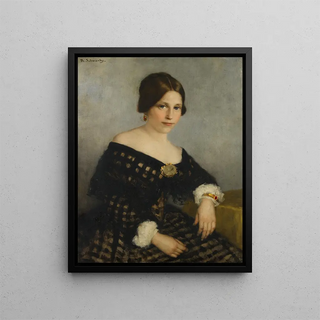Art print | Sophia Adriana de Bruijn 1816–1890 - Thérèse Schwartze


View from behind

Frame (optional)
In the vast panorama of art history, certain works stand out for their ability to capture the very essence of their era. The art print of "Sophia Adriana de Bruijn 1816–1890 - Thérèse Schwartze" is a striking example. This portrait, imbued with delicacy and depth, transports us to the 19th century, a period marked by social and artistic upheavals. Through Schwartze's gaze, we discover not only a singular figure but also a reflection on the role of women in her society. The finesse of the features, the subtle light illuminating Sophia's face, and the carefully chosen background reveal a technical mastery that invites contemplation.
Style and uniqueness of the work
Thérèse Schwartze's style is distinguished by its intimate approach and its ability to establish an emotional connection between the subject and the viewer. In this portrait, the softness of the colors and the precision of the details create a warm and welcoming atmosphere. The choice of clothing, richly textured, demonstrates particular attention to the fashions of her time, while highlighting Sophia's personality. The artist manages to transcend the simple portrait to offer a true visual narrative, where each element contributes to the story glimpsed behind the model's gaze. The balanced composition and skillful use of light emphasize Sophia's natural beauty, while evoking a certain melancholy, reflecting the aspirations and struggles of women of her time.
The artist and her influence
Thérèse Schwartze, an emblematic figure of her era, managed to establish herself in an artistic environment often dominated by men. Born in 1851, she was not only a pioneer in portraiture but also paved the way for other female artists. Her work is marked by a unique sensitivity, allowing her to capture the soul of her subjects. Schwartze integrated various influences, ranging from realism to pre-impressionism, while developing a personal style that is entirely her own. Her contribution to art is undeniable, and her impact is felt

Matte finish

View from behind

Frame (optional)
In the vast panorama of art history, certain works stand out for their ability to capture the very essence of their era. The art print of "Sophia Adriana de Bruijn 1816–1890 - Thérèse Schwartze" is a striking example. This portrait, imbued with delicacy and depth, transports us to the 19th century, a period marked by social and artistic upheavals. Through Schwartze's gaze, we discover not only a singular figure but also a reflection on the role of women in her society. The finesse of the features, the subtle light illuminating Sophia's face, and the carefully chosen background reveal a technical mastery that invites contemplation.
Style and uniqueness of the work
Thérèse Schwartze's style is distinguished by its intimate approach and its ability to establish an emotional connection between the subject and the viewer. In this portrait, the softness of the colors and the precision of the details create a warm and welcoming atmosphere. The choice of clothing, richly textured, demonstrates particular attention to the fashions of her time, while highlighting Sophia's personality. The artist manages to transcend the simple portrait to offer a true visual narrative, where each element contributes to the story glimpsed behind the model's gaze. The balanced composition and skillful use of light emphasize Sophia's natural beauty, while evoking a certain melancholy, reflecting the aspirations and struggles of women of her time.
The artist and her influence
Thérèse Schwartze, an emblematic figure of her era, managed to establish herself in an artistic environment often dominated by men. Born in 1851, she was not only a pioneer in portraiture but also paved the way for other female artists. Her work is marked by a unique sensitivity, allowing her to capture the soul of her subjects. Schwartze integrated various influences, ranging from realism to pre-impressionism, while developing a personal style that is entirely her own. Her contribution to art is undeniable, and her impact is felt






